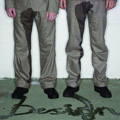Lately I have been thinking a lot about space. Not space as in Star Trek space, but space as in the space around us. Space as in the invisible boundaries we’ve designed around ourselves to create a sense of privacy, of protection and space to create a sense of self.
I had three experiences in a row provoking this inner dialogue. The first occurred while riding an elevator up to the seventeenth floor of my office, which is in the Empire State Building. It is a huge, bustling monolith, with people dashing out and about, and hoards of tourists snapping pictures. On this particular day, I was happily able to snag an elevator to myself and was avidly distracted by the strangely hypnotic television screens broadcasting the latest news, time and temperature.
The car stopped at the seventh floor and a man got on. Ordinarily, when getting on an elevator, a very silent but pervasive series of mannerisms, quirks and behaviors set forth. Mostly, people tend to retreat to a corner of their own, and will often move several feet from where they are to allow for a comfortable spatial distance to form around themselves. This seems to be done almost automatically. However, this particular gentleman did not retreat to a corner. He stood directly behind me. He wasn’t close enough to actually touch me; he wasn’t being offensive in any way. He was just spatially too close, given how much room was in the rest of the elevator. When I got off on the seventeenth floor, I felt oddly perturbed.
My second experience occurred as I was walking home from work. There were lots of people coming and going, racing home for dinner, American Idol, and that wonderful first glass of wine. Then, out of nowhere, a woman caught up to my pace, and started walking parallel with me. Not ahead of me by a few steps, not behind me by a foot or two, but right next to me, as if we were companions, walking side by side. She didn’t seem to be trying to pass me, as is often the case when I am walking wearing high heels. She just matched my step. Again, I felt odd. And then relieved when I turned the corner and she didn’t.
According to a paper written by psychologists Allyn & Bacon, environmental psychology is the study of how physical settings affect human behavior. It also studies how people govern their environment. Environmental psychologists often act as consultants to governments, schools, hospitals, churches, and museums. They might improve museum layouts to create more dynamic displays. In many cases, these psychologists study environmental variables, like crowding and spatial density, and how people can become apathetic or even hostile when they feel uncomfortable or encroached. Another noted psychologist, G. Stanley Hall, suggested that personal space is a mechanism by which people communicate with others, similar to verbal communication, body language and written or designed communication. He proposed that people first adhere to norms of personal space in childhood. But this is also a very Western concept, wherein large personal space is insisted on, with proximity reserved for close friends. In some Arab and Eastern cultures, for example, there is a much smaller distance between strangers that is acceptable.
To explain personal space in the U.S., Hall classified four spatial zones:
--An intimate distance of zero to 18 inches is maintained between people who are highly familiar with one another
--A personal distance of 1.5 to 4 feet is acceptable between friends and acquaintances
--Social distance (4 to 12 feet) is used for business and interaction with strangers
--Public distance of 12 to 25 feet or more minimizes personal contact
All of these zones seem rather logical; in fact, I find they allow for an easy explanation of why we might want to step away from someone we don’t know in a closed elevator. But my third and final experience—what would ordinarily be considered a fairly common phenomenon—proved rather remarkable in the face of these findings. Traveling downtown during rush hour to meet a friend for dinner, I found myself crushed into a pile of people without even a handrail to hang on to. Whenever the train stopped, I fell forward or sideways, tumbling deeper into the strangers surrounding me. I wasn’t traveling with any of them, per se, and yet I knew the woman next to me smelled like she was wearing Obsession by Calvin Klein and the teenager to my left was listening to “This Is Why I Am Hot” on her iPod and the man on my right was reading Prozac Nation, and the man next to him had circles of sweat under his arms and the woman across from us had chipped finger nail polish, a button missing on the sleeve of her blouse and was carrying what was likely her dinner in a white paper bag from Quiznos. Suddenly I realized, for whatever reason, it was perfectly acceptable to lose all conventional mannerisms of spatial zoning in an effort to allow one more person to stuff themselves, mosh-style, into a subway car in order to ensure that they, too, could get to dinner on time. Quite naturally and without giving it a second thought, all of this was done without the slightest hint of verbal communication or a fleeting glance in someone’s eyes. The irony of the earlier anxiety I felt during the ride with the man in the elevator or walking with the woman on the street was not lost on me. Space, in this case, was extremely relative and mutually nullified.
And yet, amidst all of our quirky physical machinations to maintain spatial autonomy, we still seek to understand where we belong and how we fit in—or not. When we design, we attempt to analyze the space between letters, tension between colors, patterns in the grid, negative space on the page. How elements best work together—or don’t. The rest of the time we orbit and navigate around the people and things we want to get close to, those we want to step away from, those we try not to notice, those we try to get to notice us, what our boundaries are and why.



















